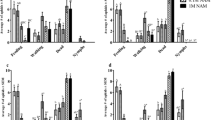Abstract
SORGHUM leaves contain the cyanoglycoside dhurrin located in the cell vacuole1, and when the tissue is crushed, hydrolysis of dhurrin by an enzyme system probably present in the cytoplasm1 results in the release of HCN. Cyanogenesis is probably a mechanism to protect plants from being eaten by herbivores2,3. It is generally assumed that this protection is conferred by the toxic effects of cyanide but the mechanism has not been fully investigated and the cyanoglycosides themselves or the other end products of hydrolysis may deter feeding. The degree of liberation of HCN in leaves is dependent on the age and variety of plant, as well as on certain environmental factors4–7. Leaves of young Sorghum are often rejected at the first bite by the graminivorous locust, Locusta migratoria8 but older Sorghum is eaten in large quantity. We show here that change in palatability is related to the rate at which HCN is released from the leaf at the time of biting.
This is a preview of subscription content, access via your institution
Access options
Subscribe to this journal
Receive 51 print issues and online access
$199.00 per year
only $3.90 per issue
Buy this article
- Purchase on Springer Link
- Instant access to full article PDF
Prices may be subject to local taxes which are calculated during checkout
Similar content being viewed by others
References
Saunders, J. A., Conn, E. E., Chin Ho Lin & Stocking, R. C. Plant Physiol. 59 647–652 (1977).
Jones, D. A. in Taxonomy and Ecology (ed. Heywood, V. H.) 213–242 (Academic, London, 1973).
Dement, W. A. & Mooney, H. A. Oecologia 15, 65–76 (1974).
Dunstan, W. R. & Henry, T. A. Phil. Trans. R. Soc., Lond. A 199, 399–410 (1902).
Williaman, J. J. & West, R. M. J. agric. Res. 4, 179–185 (1915).
James, J. H. & Gray, E. Agron. J. 67, 82–84 (1975).
Hogg, P. G. & Ahlgren, H. L. J. agric. Res. 67, 195–210 (1963).
Bernays, E. A., Chapman, R. F., Horsey, J. & Leather, E. M. Bull. ent. Res. 64, 413–420 (1974).
Towers, G. H. N., McInnes, A. G. & Neish, A. C. Tetrahedron 20, 71–77 (1964).
Akazawa, T., Miljanich, P. & Conn, E. E. Plant Physiol. 35, 535–538 (1960).
Bough, W. A. & Gander, J. E. Phytochemistry 11, 209–213 (1972).
Nayer, J. K. & Fraenkel, G. Ann. ent. Soc. Am. 56, 174–176 (1963).
Cooper-Driver, G. A. & Swain, T. Nature 260, 604 (1976).
Bernays, E. A., Chapman, R. F., McCaffery, A., Modder, W. & Leather, E. M. Bull. ent. Res. (in the press).
Author information
Authors and Affiliations
Rights and permissions
About this article
Cite this article
WOODHEAD, S., BERNAYS, E. Changes in release rates of cyanide in relation to palatability of Sorghum to insects. Nature 270, 235–236 (1977). https://doi.org/10.1038/270235a0
Received:
Accepted:
Issue Date:
DOI: https://doi.org/10.1038/270235a0
This article is cited by
-
10.1007/BF00290800
CrossRef Listing of Deleted DOIs (2011)
-
Cyanogenic glucosides as defense compounds
Journal of Chemical Ecology (1988)
-
The effect of wilting on palatability of plants to Schistocerca gregaria, the desert locust
Oecologia (1986)
-
Wound induced defences in plants and their consequences for patterns of insect grazing
Oecologia (1983)
-
Leaf-cutting ants and avoided plants: Defences against Atta texana attack
Oecologia (1982)
Comments
By submitting a comment you agree to abide by our Terms and Community Guidelines. If you find something abusive or that does not comply with our terms or guidelines please flag it as inappropriate.



